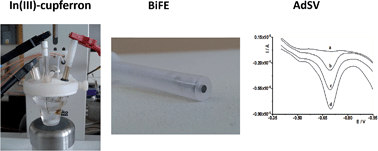Adsorptive stripping voltammetry of In(iii) in the presence of cupferron using an in situ plated bismuth film electrode
Abstract
A sensitive and selective method for the determination of trace concentration of indium in natural water samples using adsorptive stripping voltammetry at an in situ plated bismuth film electrode was described. This procedure applied cupferron as a complexing agent and was based on simultaneous bismuth film formation and In(III)–cupferron complex preconcentration at −0.65 V and its cathodic stripping during the potential scan. Experimental conditions such as the concentration of cupferron, the pH of the supporting electrolyte, conditions of bismuth film formation, accumulation potential and accumulation time were established. The optimum analytical conditions included: 0.1 mol L−1 acetate buffer (pH = 4.5), 1 × 10−4 mol L−1 cupferron, and 4 × 10−4 mol L−1 bismuth. The calibration graph was linear from 5 × 10−9 mol L−1 to 5 × 10−7 mol L−1 for accumulation time of 60 s. The detection limit was 1.6 × 10−9 mol L−1 with the correlation coefficient of 0.998. The influence of interfering substances such as surfactants and humic substances present in the matrices of natural water samples was studied. The proposed method was validated in the course of In(III) recovery determination from spiked natural water samples like river water and lake water.


 Please wait while we load your content...
Please wait while we load your content...